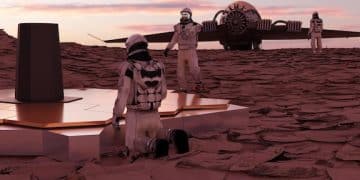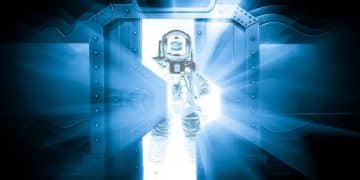Starship vs. SLS: Which offers best value for deep space in 2025?
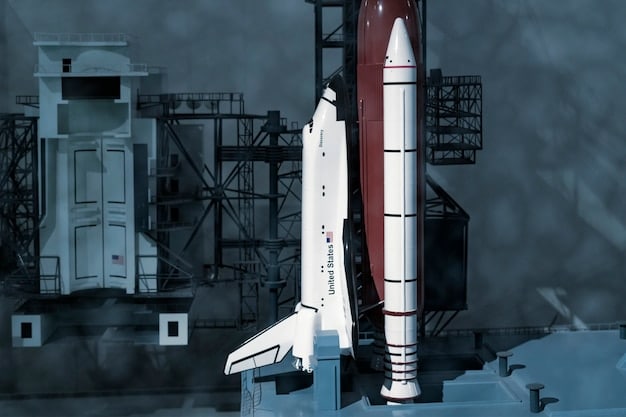
The comparison between SpaceX’s Starship and NASA’s Space Launch System (SLS) for deep space exploration value in 2025 reveals distinct philosophies: Starship prioritizes reusability and high-cadence launches for cost-efficiency, while SLS represents a traditional, powerful architecture with proven legacy but higher per-launch expenses, each offering unique strengths for future human and robotic missions beyond Earth orbit.
In the evolving landscape of space exploration, two colossal rockets stand poised to redefine humanity’s reach into the cosmos: SpaceX’s Starship and NASA’s Space Launch System (SLS). A critical assessment involves a comparison: SpaceX Starship vs. NASA’s SLS – which rocket offers the best value for deep space exploration in 2025? This inquiry goes beyond mere thrust, delving into engineering philosophies, operational costs, mission flexibility, and long-term strategic implications for our journey to the Moon, Mars, and beyond.
The evolving landscape of heavy-lift rockets
The dawn of the 21st century has heralded a new era in spaceflight, characterized by ambitious deep space exploration goals and a drive towards more sustainable access to orbit. At the heart of this transformation are heavy-lift launch vehicles, capable of sending enormous payloads and, crucially, humans far beyond low Earth orbit. These rockets are not just means of transport; they are fundamental enablers of scientific discovery, commercial expansion, and national prestige.
The development of these next-generation launchers has been shaped by decades of engineering advancement, shifting political priorities, and the emergence of private sector innovation. While the foundational principles of rocketry remain, the approaches to achieving unparalleled lift capabilities and mission flexibility have diversified significantly. This divergence is most evident when examining the two titans set to dominate lunar and Martian aspirations in the mid-2020s.
One key aspect of this evolution is the increasing emphasis on advanced manufacturing techniques and materials, which promise lighter, stronger structures. Another is the push towards greater autonomy in launch operations, reducing the human footprint and potential for error. These elements, combined with a re-evaluation of economic viability, are fundamentally altering how we perceive and execute deep space missions.
Design philosophy and engineering principles
The design philosophies underpinning Starship and SLS represent divergent paths to achieving heavy-lift capabilities. SLS, a product of traditional aerospace contracting, emphasizes a robust, highly capable, and somewhat expendable architecture, leveraging legacy hardware from the Space Shuttle and Apollo programs. Its design prioritizes raw power and a proven safety record, building upon decades of NASA’s experience.
Starship, conversely, is conceived on a paradigm of rapid iteration, full reusability, and mass production. SpaceX’s approach emphasizes scale, cost reduction through reusability, and a “build-and-test” philosophy that allows for quick design changes and improvements. This fundamentally alters the economic model for accessing space, with the potential to dramatically lower the per-kilogram cost to orbit and beyond.
- SLS: Built on heritage systems, prioritizing reliability and brute force.
- Starship: Focus on rapid reusability and high launch cadence for cost efficiency.
- Operational Flexibility: SLS for singular, high-value government missions; Starship for various commercial and government roles.
These contrasting philosophies extend to their chosen propulsion systems and structural designs. SLS relies on two types of solid rocket boosters and four RS-25 liquid-fueled engines for its core stage, a testament to its heritage. Starship utilizes highly efficient Raptor engines, designed for reusability and fueled by liquid methane and liquid oxygen, a choice that has significant implications for future in-situ resource utilization on other celestial bodies. The materials used, manufacturing processes, and integration complexities further differentiate these engineering marvels. The choices made during their conception directly influence their operational profiles, maintenance requirements, and ultimately, their long-term value proposition.
SpaceX Starship: The reusable giant
SpaceX’s Starship represents a radical departure from conventional rocket design, aspiring to be a fully reusable transportation system capable of carrying both cargo and humans to the Moon, Mars, and beyond. Its core philosophy revolves around rapid reusability, aiming to significantly drive down the cost of spaceflight and enable a sustainable presence across the solar system.
The vehicle consists of two fully reusable stages: the Starship spacecraft itself and the Super Heavy booster. Both are powered by SpaceX’s proprietary Raptor engines, which operate on liquid oxygen and liquid methane. This propellent combination is particularly attractive for long-duration space missions, as methane can potentially be produced on Mars or the Moon using in-situ resources, making propellant depots and refueling an achievable reality for deep space journeys.
A key aspect of Starship’s design is its ability to perform in-orbit refueling. For extended deep space missions, multiple tanker Starships would launch to low Earth orbit to fill the primary Starship’s tanks, allowing it to escape Earth’s gravity with a far greater payload capacity than would otherwise be possible. This innovative approach is central to its utility for missions requiring substantial mass, such as large habitats, scientific equipment, or hundreds of tons of supplies for Martian settlements.
Operational model and reusability challenges
The operational model for Starship is predicated on achieving rapid turnaround times, akin to commercial airlines. This requires robust, durable components and efficient ground operations infrastructure. However, achieving full and rapid reusability for a vehicle of this scale presents unprecedented engineering and logistical challenges. Every launch and landing attempt provides valuable data, informing design improvements and refining operational procedures.
Each test flight, whether a short hop or an ambitious orbital attempt, furthers the development process. The iterative “build, test, fly, learn” philosophy allows SpaceX to quickly identify and address issues, but it also means that Starship’s development path is characterized by highly visible and sometimes dramatic failures. Overcoming the technical hurdles of atmospheric re-entry, precise landing maneuvers, and engine reliability across multiple uses are critical for Starship to fulfill its promise.
- Full Reusability: Both booster and spacecraft designed for repeated flights.
- In-Orbit Refueling: Essential for maximizing deep space payload capacity.
- Rapid Iteration: Development through frequent testing and learning from failures.
The economic value proposition of Starship hinges on its ability to drastically reduce the cost per launch by spreading development and manufacturing costs over numerous missions. If Starship can achieve frequent, reliable, and fully reusable flights, its operational costs per mission could be orders of magnitude lower than traditional expendable launch vehicles. This financial efficiency, combined with its immense payload capacity, makes it a compelling contender for future deep space endeavors, from lunar bases to crewed Mars missions.
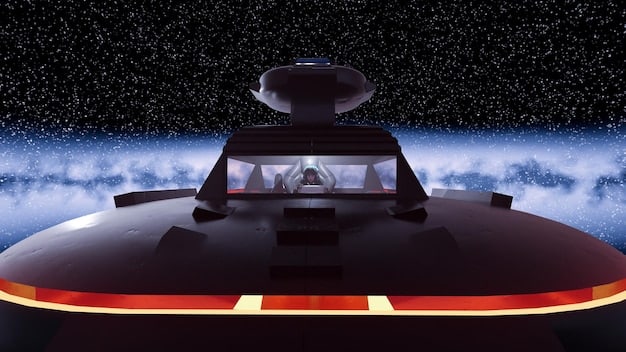
NASA’s Space Launch System (SLS): The traditional powerhouse
NASA’s Space Launch System (SLS) stands as the cornerstone of the Artemis program, designed to return humans to the Moon and later venture to Mars. Unlike Starship’s focus on reusability, SLS is a traditional expendable heavy-lift rocket, built for unparalleled power and reliability for singular, high-value missions. Its development represents a continuation of NASA’s long-standing approach to human spaceflight infrastructure, leveraging heritage components from the Space Shuttle and Apollo programs.
The SLS is an immense rocket, with its initial Block 1 configuration capable of lifting over 27 metric tons to translunar injection, a capability that will increase with future upgrades. It comprises a core stage powered by four RS-25 engines, derived from the Space Shuttle Main Engines, and two solid rocket boosters (SRBs) on its sides, providing the majority of the thrust during the initial ascent phase. Its upper stage, the Interim Cryogenic Propulsion Stage (ICPS), propels the Orion spacecraft, its primary payload, towards its deep space destinations.
The design of SLS prioritizes proven technologies and redundant systems to maximize mission success and crew safety. Its robust construction and powerful engines are tailored for complex deep space trajectories, ensuring the Orion spacecraft and its crew can safely reach and return from lunar orbits and eventually, Mars. This focus on reliability and high performance from a single launch significantly shapes its mission profile and operational strategy.
Development history and cost implications
The development of SLS has been a protracted and costly endeavor, stretching over a decade with expenditures reaching into the tens of billions of dollars. Its genesis lies in the Constellation program, which was later canceled, leading to the creation of SLS through congressional mandate. This long development timeline and reliance on a broad network of traditional aerospace contractors contribute to its high per-launch cost.
Each SLS launch is a monumental undertaking, involving extensive manufacturing, assembly, and testing processes for components that are largely expended after a single use. The cost per launch for the SLS, particularly its initial flights, is estimated to be in the billions of dollars, a figure that has drawn significant scrutiny and debate. While some of these costs are attributed to developing new capabilities and infrastructure for deep space, the expendable nature of much of the rocket means these costs are incurred repeatedly for each mission.
- Expensable Design: Core stages and boosters are discarded after launch.
- High Development Costs: Billions invested over more than a decade.
- Heritage Components: Utilizes proven Space Shuttle and Apollo-era technologies.
The significant investment in SLS reflects a strategic decision to ensure a government-controlled heavy-lift capability for critical national missions, independent of commercial providers. While this provides continuity and direct oversight for ambitious programs like Artemis, it also implies a lower launch cadence compared to reusable systems. The trade-off is between guaranteed capability for specific high-priority missions and the economic efficiency offered by emerging reusable architectures. The value of SLS is therefore framed by its reliability and its critical role in enabling the first crewed lunar landings in over 50 years.
Performance metrics: Starship vs. SLS
Apples-to-apples comparisons of rocket performance are notoriously complex due to differing architectures, operational modes, and mission profiles. However, examining key metrics provides insight into the intrinsic capabilities of both Starship and SLS, particularly concerning their suitability for deep space exploration in 2025 and beyond. The primary metrics considered are payload capacity, volume, and operational thrust, as these define what kinds of missions each vehicle can enable.
Payload capacity to various orbits and destinations is perhaps the most crucial differentiator. The SLS Block 1, the initial operational version, can lift over 27 metric tons directly to Translunar Injection (TLI), sufficient for the Orion spacecraft and associated hardware for lunar missions. Future SLS configurations (Block 1B and Block 2) promise even greater capacities, upwards of 42 metric tons to TLI. Starship, when fully refueled in orbit, is projected to deliver over 100 metric tons to TLI, a significantly higher figure. This immense capacity is foundational to SpaceX’s vision of large-scale lunar bases and Martian settlements, as it allows for the transport of massive habitats, factories, and significant quantities of supplies.
Volume capacity is another critical factor. Starship boasts an enormous internal volume, far exceeding SLS’s payload fairing dimensions. This allows Starship to accommodate large, pre-integrated structures that would otherwise require on-orbit assembly or be too bulky for conventional rockets. This capability streamlines mission planning for large-scale habitats, scientific instruments, or even fully deployed landers.
Propulsion and operational thrust
While payload capacity is key, the sheer power and characteristics of their propulsion systems are also worth noting. SLS’s initial thrust comes from its solid rocket boosters and four RS-25 core stage engines, generating millions of pounds of thrust at liftoff. These are highly reliable, well-understood engines, providing a powerful initial push.
Starship’s Raptor engines, conversely, represent a new generation of full-flow staged combustion engines. While individually less powerful than an RS-25, the sheer number of Raptors (33 on Super Heavy, 6 on Starship) combined deliver immense collective thrust. Crucially, their design for reusability means they are built for repeated flight cycles, a stark contrast to the expendable nature of SLS’s components.
- Payload to TLI: Starship (refueled) significantly surpasses SLS.
- Internal Volume: Starship offers vastly greater space for large payloads.
- Thrust Profile: Both generate immense liftoff thrust, but with different engine types and operational philosophies.
The different propulsion choices also affect mission flexibility. Starship’s ability to refuel in orbit means it can tailor its deep space payload by adding more or fewer tanker flights, optimizing for specific mission needs. SLS’s capacity is largely fixed per configuration. Therefore, while SLS offers brute force and direct insertion for critical missions, Starship’s modularity and vast capacity, achieved through orbital refueling, provide a different kind of flexibility and scalability for future human expansion into the solar system.
Cost-effectiveness and economic models
The debate over value in deep space exploration often distills down to cost-effectiveness, an area where Starship and SLS present fundamentally different economic models. Understanding these models is crucial for assessing which rocket offers the “best value” in 2025, considering both immediate expenditures and long-term implications for space access.
The Space Launch System operates under a traditional government contracting model, where development and manufacturing costs are substantial and spread across multiple prime contractors and subcontractors. Each SLS launch incurs significant costs due to its largely expendable nature. Components like the core stage and solid rocket boosters are built for single use, meaning their immense fabrication and assembly costs are absorbed by each individual mission. While precise figures vary and are subject to ongoing debate, estimates for the per-launch cost of SLS often range in the billions of dollars. This model prioritizes mission assurance and the maintenance of a skilled industrial base, often at the expense of fiscal efficiency per launch.
Conversely, SpaceX’s Starship is designed around the principle of full and rapid reusability. The initial development costs for Starship are considerable, but the long-term economic strategy is to significantly reduce the per-launch cost by reusing both the Super Heavy booster and the Starship spacecraft multiple times. If Starship can achieve frequent, reliable reflights with minimal refurbishment, the cost of each mission would be dramatically lower, potentially in the tens of millions of dollars. This model aims to treat space launches more like commercial airline flights, where the fixed costs of the vehicle are amortized over hundreds or thousands of expeditions. While Starship is still in its heavy testing phase, the ultimate goal is to make access to space routinely affordable.
Long-term implications for space economics
The economic models of Starship and SLS have profound long-term implications for the future of space exploration. The high recurring costs of SLS missions mean that deep space endeavors, particularly crewed ones, will remain episodic and resource-intensive, funded primarily through large government appropriations. This limits the achievable cadence of missions and the overall scale of human presence beyond Earth.
Starship’s objective of ultra-low-cost access could unlock entirely new economic possibilities in space. If successful, it could enable economically viable industries in cislunar space (e.g., lunar resource extraction, space tourism, in-orbit manufacturing). Its predicted affordability would also allow for much higher mission cadences, accelerating scientific discovery, infrastructure build-out, and human settlement. The difference isn’t just about launching rockets; it’s about shifting the economic paradigm of space, potentially opening it up to ventures that are currently cost-prohibitive.
- SLS: High per-launch cost due to expendable design and traditional contracting.
- Starship: Projected ultra-low per-launch cost via full reusability and high cadence.
- Economic Impact: SLS maintains episodic, government-led missions; Starship aims to enable new space industries.
Therefore, when assessing value, it’s not simply the price tag of a single launch but the enabling effect it has on the entire domain of deep space activities. SLS offers assured capability for specific, critical missions within a well-established framework. Starship, on the other hand, presents a disruptive potential to lower the barrier to entry for a wide array of deep space activities, fundamentally altering the economics of off-Earth exploration and development. The choice between them often reflects a strategic decision regarding funding models, risk tolerance, and the desired pace of space commercialization.
Mission flexibility and strategic objectives
The utility of a heavy-lift launch vehicle extends beyond its raw performance and cost; its mission flexibility and alignment with strategic objectives are equally critical. Both Starship and SLS are designed to serve ambitious goals, but their architectural differences lend themselves to distinct operational profiles and support different long-term visions for deep space exploration.
NASA’s SLS is the backbone of the Artemis program, whose primary strategic objective is to return humans to the Moon, establish a sustainable lunar presence, and prepare for eventual crewed missions to Mars. SLS is specifically designed to launch the Orion spacecraft directly to the Moon, ensuring crew safety and mission reliability for these high-stakes expeditions. Its direct-to-TLI capability, bypassing the need for complex on-orbit assembly or refueling, simplifies mission architecture for initial lunar sorties. This streamlined approach aligns well with a phased, government-led exploration campaign where each launch is a significant, well-resourced event. The flexibility of SLS lies in its ability to support various Orion configurations and associated co-manifested payloads, though these are typically tailored to specific lunar or Martian trajectories.
Starship, in contrast, aims for a far broader spectrum of missions, from satellite deployment to interplanetary travel. Its massive payload volume and in-orbit refueling capability make it uniquely suited for deploying large-scale infrastructure in space, such as entire space stations, telescopes, or lunar/Mars settlement modules. SpaceX’s strategic objective extends to colonizing Mars, and Starship is positioned as the primary vehicle to achieve this, capable of transporting hundreds of tons of cargo or potentially 100+ people per trip to the Red Planet. This flexibility extends to its potential use as a point-to-point Earth transporter, further diversifying its mission portfolio beyond traditional space launches.
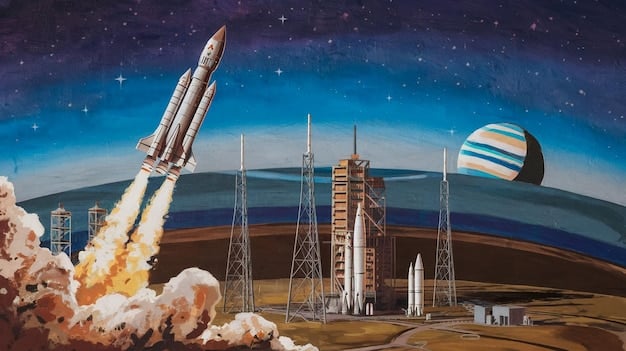
Government needs versus commercial aspirations
The strategic objectives of SLS are inherently government-driven, focused on achieving national goals for human spaceflight and scientific discovery under NASA’s direct purview. This includes maintaining national leadership in space and fostering a domestic industrial base. The slower, more methodical pace of SLS development and operations reflects this focus on certainty and control for high-profile crewed missions.
Starship, while also contracted by NASA for elements like the Human Landing System (HLS) for Artemis, operates primarily within a commercial framework driven by SpaceX’s ambitious commercial and interplanetary goals. Its rapid iteration and pursuit of radical cost reduction are foundational to enabling private ventures and a much higher frequency of launches. This commercial agility could allow for quicker adaptation to new mission requirements and open up space to a wider range of private sector initiatives, accelerating the pace of off-world development in ways a purely governmental approach might not.
- SLS Strategic Focus: Government-led lunar and Martian human exploration via Artemis.
- Starship Strategic Focus: Broad, high-cadence access for both government and extensive commercial/interplanetary colonization.
- Mission Scope: SLS for specific crewed deep space direct insertions; Starship for vast payload deployment and mass transit capabilities.
Ultimately, the choice of which rocket offers “best value” often depends on the specific strategic objective. For assured, direct-to-destination crewed lunar missions within a government framework, SLS provides a powerful and reliable solution. For enabling a persistent, cost-effective human presence and establishing infrastructure beyond Earth, with an eye towards eventual Mars settlement, Starship’s broad flexibility and economic model present a compelling, albeit still developing, alternative. The future of deep space exploration will likely see both vehicles playing complementary, rather than mutually exclusive, roles.
Challenges and outlook for 2025
As 2025 approaches, both the SpaceX Starship and NASA’s SLS face distinct challenges and opportunities that will shape their roles in deep space exploration. While both promise revolutionary capabilities, their paths to operational maturity and widespread utility are marked by unique hurdles in development, testing, funding, and regulatory approval.
For Starship, the primary challenge remains achieving reliable, rapid, and fully reusable flight. Despite significant progress and ambitious test flight campaigns, the system has yet to demonstrate the in-orbit refueling capabilities critical for deep space missions, nor has it achieved consistent, high-cadence reusability. The iterative development approach, while fast, can lead to setbacks that delay full operational readiness. Additionally, navigating the complex regulatory environment, particularly for launch and landing operations in south Texas, presents its own set of challenges. SpaceX’s outlook for 2025 hinges on successfully demonstrating key technological milestones and proving the economic viability of its reusability model through consistent flight operations.
The SLS, on the other hand, faces challenges primarily related to cost, launch cadence, and supply chain reliability. Having completed its inaugural Artemis I mission, the rocket has proven its core capability. However, its high per-launch cost limits the frequency of missions – currently, only one or two launches are projected per year, far fewer than needed for rapid lunar base build-up. Ensuring timely production of components and managing a complex network of traditional aerospace contractors can also introduce delays and budget overruns. The outlook for SLS in 2025 involves maintaining its impressive reliability, demonstrating crewed capabilities with Artemis II, and delivering consistent performance within its projected budget and schedule for future Artemis missions.
Future roles and collaboration potential
Looking ahead to 2025 and beyond, it’s increasingly clear that Starship and SLS may not be direct competitors but rather complementary assets for deep space exploration. SLS is poised to continue its role as the primary launcher for the Orion capsule and its human crews to lunar orbit, especially for initial lunar landings and complex scientific expeditions that demand its direct trajectory capabilities and proven system reliability.
Starship, if its reusability and in-orbit refueling are fully proven, is ideally suited to complement SLS by carrying the immense quantities of cargo, habitats, and infrastructure needed for sustained lunar operations and eventual Mars colonization. For example, Starship has been selected as the Human Landing System (HLS) for Artemis III, meaning it will be the vehicle that takes astronauts from lunar orbit to the surface of the Moon. This signifies a recognition within NASA that Starship’s unique capabilities are essential for realizing the broader goals of the Artemis program.
- Starship Challenges: Achieving reliable full reusability and in-orbit refueling.
- SLS Challenges: High recurring costs and low launch cadence.
- Complementary Roles: SLS for direct crew transport, Starship for large cargo and lunar landing.
Therefore, by 2025, rather than a clear “winner” in a head-to-head value comparison, we are likely to see a convergence where both rockets play critical, integrated roles. SLS provides the initial human lift for critical missions, while Starship enables the logistical backbone and infrastructure for building a sustained human presence beyond Earth. The best value ultimately emerges from a synergistic approach, leveraging the unique strengths of each system to advance humanity’s ambitious deep space objectives.
| Key Aspect | Brief Description |
|---|---|
| 🚀 Design Philosophy | Starship focuses on full reusability; SLS prioritizes expendable brute force and heritage. |
| 💰 Cost Model | Starship targets low per-launch cost; SLS has high recurring costs per mission. |
| 📦 Payload Capacity | Starship (refueled) offers vastly superior capacity to TLI compared to SLS. |
| 🎯 Strategic Role | SLS for crewed lunar missions; Starship for large cargo, Martian colonization, and HLS. |
Frequently Asked Questions
▼
The core difference lies in reusability. Starship is designed to be fully reusable, aiming for rapid turnaround and low per-launch costs. SLS, conversely, is largely expendable, engineered for maximum power and reliability for single, high-stakes deep space missions, leveraging heritage components from past NASA programs for proven performance.
▼
When fully refueled in orbit, SpaceX’s Starship is projected to offer significantly greater payload capacity to Translunar Injection (TLI), potentially over 100 metric tons. NASA’s initial SLS Block 1 is rated for over 27 metric tons to TLI, with future upgrades (Block 1B, Block 2) increasing this, but still less than Starship’s theoretical maximum with refueling.
▼
SLS has a very high per-launch cost, estimated in the billions of dollars, due to its expendable nature and complex government contracting. Starship aims for a dramatically lower per-launch cost, potentially tens of millions, by achieving full and rapid reusability, amortizing development and manufacturing costs over many flights, as seen with commercial aircraft.
▼
SLS is NASA’s backbone for the Artemis program, focused on returning humans to the Moon, establishing a sustainable lunar presence, and preparing for Mars missions. Starship’s strategic objectives are broader, encompassing large-scale economic activity in space, building lunar and Martian settlements, and potentially enabling routine interplanetary travel, making it crucial for the Artemis Human Landing System.
▼
By 2025, it’s highly probable that they will play complementary roles. SLS is suited for direct crew transport to lunar orbit for high-priority missions, offering proven reliability. Starship, if successful in its reusability and refueling goals, will be essential for transporting massive cargo, infrastructure, and acting as the human lunar lander for Artemis, enabling sustained lunar presence and Mars colonization.
Conclusion
The comparison: SpaceX Starship vs. NASA’s SLS – which rocket offers the best value for deep space exploration in 2025? reveals that both vehicles are monumental achievements, yet they embody fundamentally different approaches to humanity’s future in space. While SLS provides assured, powerful, direct-to-destination capability for critical government-led missions, adhering to a well-established, reliable framework, Starship offers a disruptive paradigm of unprecedented payload capacity and drastically reduced per-launch costs through full reusability. The “best value” is not a simple choice but rather depends on the specific mission, the desired cadence of operations, and the long-term vision for space commercialization versus pure exploration. In 2025, rather than a single dominant solution, a synergistic approach is emerging, where SLS could handle initial crew transportation, while Starship, with its unmatched capacity and cost-effectiveness, provides the logistical backbone for building a sustainable human presence across the solar system, making both indispensable for advancing human exploration.

